16 July 2024 : Daily Current Affairs
1. SC to look into use of Money Bills to pass laws
- 1. SC to look into use of Money Bills to pass laws
- 2. ‘India and Russia have doubled rupee-rouble payments in 2024’
- 3. ISRO has a problem: many rockets, but too few satellites to launch
- 4. Supreme Court Declares Assam Resident a Citizen of India, Overturns Foreigners’ Tribunal Decision
- 5. Centre Sets Up Committee to Investigate IAS Officer Puja Khedkar’s Candidature and Allegations of Misconduct
- 6. Tizu Zunki River to be harnessed for Economic Development of Nagaland, to enable Cargo & Passenger Transport: Shri Sarbananda Sonowal
- 7. “India Aims to Become Leading Aviation Hub with $4 Billion MRO Industry by 2030” – Union Minister Shri Rammohan Naidu
- PRELIMS FACTS
- 1. India Plans to Tackle Non-Tariff Barriers to Boost Exports to Russia, Sets $100 Billion Trade Target by 2030
- 2. Imports continue to outpace growing exports; trade deficit widens by 9.4%
- 2. Two stealth frigates being built in Russia set to be delivered soon
- 3. World’s rarest whale may have washed up on beach in New Zealand
(Source – The Hindu, International Edition – Page No. – 1)
| Topic: GS2 – Indian Polity – Judiciary |
| Context |
|

Analysis of the news:
- Chief Justice D.Y. Chandrachud has agreed to list petitions challenging the passage of contentious amendments through the Money Bill route in Parliament.
- The issue was referred to a seven-judge Bench in November 2019 by a previous five-judge Bench led by Chief Justice Ranjan Gogoi.
- The core question is whether amendments, such as those to the Prevention of Money Laundering Act and the Finance Act of 2017, were correctly passed as Money Bills, bypassing the Rajya Sabha.
- Money Bills under Article 110(1) of the Constitution are limited to specific financial matters like appropriation from the Consolidated Fund and taxation.
- The case also involves allegations that categorising certain bills as Money Bills was a tactic to increase executive control over judicial tribunals, which has been contested by petitioners including Rajya Sabha MP Jairam Ramesh.
|
PYQ: Q1. Regarding the Money Bill, which of the following statements is not correct? (UPSC Civil services Prelims 2018) (a) A bill shall be deemed to be a Money Bill if it contains only provisions relating to the imposition, abolition, remission, alteration or regulation of any tax. (b) A Money Bill has provisions for the custody of the Consolidated Fund of India or the Contingency Fund of India. (c) A Money Bill is concerned with the appropriation of money out of the Contingency Fund of India. (d) A Money Bill deals with the regulation of borrowing of money or giving of any guarantee by the Government of India. Ans: Option C |
| Practice Question: Discuss the constitutional implications and controversies surrounding the classification of bills as Money Bills in India. What are the key issues and legal challenges associated with this practice? (250 Words /15 marks) |
2. ‘India and Russia have doubled rupee-rouble payments in 2024’
(Source – The Hindu, International Edition – Page No. – 4)
| Topic: GS2 – International Relations – Bilateral Relations |
| Context |
|
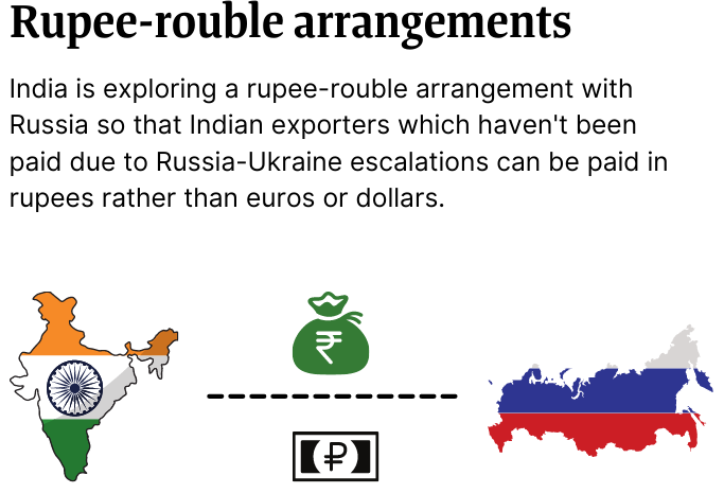
Analysis of the news:
- Sberbank reports a growing trust in the Indian rupee among its clients, with a doubling of rupee-rouble payments since last year despite U.S. and EU sanctions.
- The volume of transactions handled by Sberbank increased by 80% in the first half of 2024.
- Indian corporates have increased rupee deposits significantly, with a sixfold rise in corporate deposits in 2024.
- Prime Minister Narendra Modi’s recent visit to Moscow aims to boost economic ties, targeting a $100 billion trade goal by 2030 with Russia.
- Indian businesses are urged to explore sectors like auto components, aviation, chemicals, electronics, machinery, and agriculture for exports to Russia.
- There is concern that Chinese businesses are benefiting from sanctions by filling the void left by Western companies, urging quicker action from India to strengthen trade relations with Russia.
| Practice Question: Discuss the implications of increasing trust in the Indian rupee and rising trade volumes between India and Russia amidst Western sanctions. How can India leverage this momentum to achieve its economic objectives with Russia? (150 Words /10 marks) |
3. ISRO has a problem: many rockets, but too few satellites to launch
(Source – The Hindu, International Edition – Page No. – 7)
| Topic: GS3 – Science and Technology |
| Context |
|
Launch Vehicle Capability and Market Demand
- In June, the Chairman of the Indian Space Research Organisation (ISRO) highlighted that ISRO’s launch vehicle capability exceeds current demand by threefold. This statement has raised concerns in the spaceflight sector about the state of the space launch market.
- India operates four launch vehicles: the Small Satellite Launch Vehicle (SSLV), Polar Satellite Launch Vehicle (PSLV), Geosynchronous Satellite Launch Vehicle (GSLV), and Launch Vehicle Mark-III (LVM-3). These can launch satellites up to four tonnes to geosynchronous orbit.
- For heavier payloads exceeding four tonnes, India relies on foreign launch vehicles like Europe’s Ariane V and SpaceX’s Falcon 9.
Satellite Applications and Demand Dynamics
- India’s satellite fleet serves various sectors including communications, remote sensing, navigation, meteorology, disaster management, and scientific missions. Future missions like Chandrayaan 3 and Aditya L1 require robust launch vehicle capabilities.
- The shift from a supply-driven to a demand-driven model in India’s space program, initiated in 2019-2020, means satellites are launched only when there is a specific market demand.
- Educating potential customers about satellite services becomes crucial under this model, where demand for satellites and subsequent launch vehicles is driven by identified market needs.
Challenges in Demand Creation
- The challenge lies in creating awareness and demand for space-based services among potential users such as businesses, government entities, and the general public.
- This education is essential for stimulating demand for satellites and, consequently, launch vehicles.
- Examples include the need for space-based internet services where demand must be generated before satellite constellations are launched to provide the service.
Limitations and Upgrades in Launch Vehicles
- India’s current launch vehicles have limitations for certain missions; for instance, Chandrayaan 4 would require multiple launches of the LVM-3 due to payload capacity constraints compared to vehicles like China’s Long March 5.
- ISRO plans to enhance capabilities with semi-cryogenic engines for LVM-3 and proposes the Next Generation Launch Vehicle (NGLV) to handle heavier payloads up to 10 tonnes to geostationary transfer orbit (GTO), pending funding approvals.
- Continued success with the SSLV for smaller satellites is crucial as it encourages growth in satellite size and complexity, thereby increasing demand for launch vehicles.
Economic Considerations and Reusability
- Launch vehicle economics are improving with innovations like reusable rocket stages, reducing costs and increasing profitability.
- ISRO’s efforts include developing reusable launch and vertical landing technologies, as well as exploring greener rocket propellants.
Government and Private Sector Dynamics
- ISRO’s strategy includes transitioning to a model where the private sector plays a significant role in creating and fulfilling satellite launch demand. The government aims to be an anchor customer initially, supporting private companies in their early stages.
- Private sector expectations include clear regulatory frameworks and a reliable customer base provided by the government.
- This mirrors practices in the U.S., where government agencies contract private companies like SpaceX and Blue Origin for launch services.
- The Indian government plans to phase out direct involvement in launch operations, eventually relying on private sector capabilities to sustain demand for launch vehicles.
Conclusion
- The transition to a demand-driven model in India’s space program requires effective customer education and market stimulation to align satellite and launch vehicle production with identified needs.
- This strategic shift aims to optimise resources and foster sustainable growth in the space sector.
| PYQ: India has achieved remarkable successes in unmanned space missions including the Chandrayaan and Mars Orbiter Mission, but has not ventured into manned space missions, both in terms of technology and logistics? Explain critically. (150 words/10m) (UPSC CSE (M) GS-3 2017) |
| Practice Question: Discuss the implications of India’s transition to a demand-driven model in its space program, particularly in aligning launch vehicle capabilities with market demand. What are the challenges and strategic initiatives required to optimise this transition? (250 Words /15 marks) |
4. Supreme Court Declares Assam Resident a Citizen of India, Overturns Foreigners’ Tribunal Decision
(Source: Indian Express; Section: Explained; Page: 13)
| Topic: GS2 – Government policies – Issues arising out of their design & implementation. |
| Context: |
|
Analysis of News:
What is the Citizenship Amendment Act, 2019?
- The Citizenship (Amendment) Act, 2019 seeks to amend the Citizenship Act, 1955.
- The CAA provides citizenship on the basis of religion to six undocumented non-Muslim communities (Hindus, Sikhs, Buddhists, Jains, Parsis and Christians) from Pakistan, Afghanistan and Bangladesh who entered India on or before 31st December, 2014.
- It exempts the members of the six communities from any criminal case under the Foreigners Act, 1946 and the Passport Act, 1920.
- The two Acts specify punishment for entering the country illegally and staying here on expired visas and permits.
| National Register of Citizens |
| It is an official record of legal citizens of India. The purpose of this record is to identify and deport illegal migrants. The Citizenship Act of 1955 provides for the compulsory registration of every citizen of India and the issuance of a National Identity Card to him. The Citizenship Rules, 2003, framed under the Citizenship Act 1955, prescribe the manner of preparation of the National Register of Citizens. The National Register of Citizens (NRC) was prepared only once in 1951 after the 1951 census. Currently, Assam is the only state which has such a register. |
Facts of the Case
- Md Rahim Ali was born in Dolur village, Barpeta district. His parents were listed in the 1965 voter rolls, and a document confirmed their residence in Dolur before 1965. Ali’s name, along with his siblings’, appeared in the 1985 voter list.
- After his marriage in 1997, he moved to Kashimpur in Nalbari district, where his name was included in the voter list of the same year.
- In 2004, an investigation into Ali’s nationality was initiated by the superintendent of police in Nalbari. Due to Ali’s inability to produce sufficient documentary evidence of his nationality within a week, a case was registered against him.
- Minor discrepancies in the spellings and dates of his documents led the FT to declare him a foreigner in his absence, as he was ill and could not appear. Despite a High Court ruling upholding this declaration, the Supreme Court ordered a review, but the FT again declared him a foreigner, alleging illegal entry into India post the cut-off date of March 25, 1971.
On the Burden of Proof
- Section 9 of The Foreigners Act, 1946, places the burden of proof on the individual alleged to be a foreigner. However, the Supreme Court questioned whether this section permits the Executive to randomly accuse individuals of being foreigners without substantial evidence.
- The Court found no evidence against Ali and noted the absence of information regarding who filed the complaint or the source of the claim that Ali was from Mymensingh, Bangladesh.
- The Court emphasized that the burden of proof on the accused can only be discharged once the state has shared the basis of its allegations. This sharing of material is essential to the principle of natural justice, which mandates that no one should be condemned unheard.
- The judgment highlighted that proceedings with severe consequences for individuals should not be based on hearsay or vague allegations.
- Citing the five-judge verdict in Mukesh Singh vs State (2020), the Court reiterated that even in cases of reverse burden of proof, the initial burden rests on the prosecution.
- As per Noor Aga vs State of Punjab (2008), the prosecution must prove some basic facts even when the burden of proof is reversed. The seriousness of the offense dictates the degree of proof required.
Discrepancy in Spellings
- The judgment addressed concerns regarding minor spelling mistakes and discrepancies in dates, especially in the context of the Citizenship (Amendment) Act, 2019, and the proposed nationwide National Register of Citizens (NRC).
- The Court acknowledged that variations in name spellings are common in voter rolls due to casual entries by enumerators.
- It criticized the Tribunal for not considering these common discrepancies and for its insensitivity to the realities of name variations and aliases in India.
Foreigners’ Tribunals
- Foreigners’ Tribunals, established under the colonial-era Foreigners Act of 1946, were intended to deal with foreigners, not citizens.
- These Tribunals were created by an executive order of the Home Ministry in 1964, though the Constitution allows for tribunals to be established by appropriate legislatures.
- According to Section 2(a) of the 1946 Act, a foreigner is someone who is not a citizen of India. This provision applies to individuals with substantial evidence against them, such as being caught entering India illegally or possessing a foreign passport.
- However, in Assam, about 3 lakh people were declared Doubtful Voters in 1997 and later years without proper inquiry or notice. These individuals were excluded from the Assam NRC and faced Foreigners’ Tribunals.
- Notices issued by the FTs often lack specific grounds for allegations, leaving individuals to defend themselves without knowing the charges. Until March 2019, 1.17 lakh people were declared foreigners, many without their presence. The Supreme Court’s judgment could significantly impact the thousands of pending cases in these Tribunals.
| What are the Associated Concerns with CAA? |
|
Exclusionary Nature:
Contradiction with Secularism:
Undermining Pluralism:
Constitutional Challenge:
Impact on Assam Accord:
|
|
PYQ: With reference to India, consider the following statements: (2021) 1) There is only one citizenship and one domicile. 2) A citizen by birth only can become the Head of State. 3) A foreigner once granted citizenship cannot be deprived of it under any circumstances. Which of the statements given above is/are correct? (a) 1 only (b) 2 only (c) 1 and 3 (d) 2 and 3 Ans: (a) |
| Practice Question: Discuss the implications of the Supreme Court’s judgment in the case Assam resident on the burden of proof in cases of alleged foreign nationality under the Foreigners Act, 1946. How does this judgment address the procedural shortcomings of Foreigners’ Tribunals and their impact on individuals in Assam? (250 words/15 m) |
5. Centre Sets Up Committee to Investigate IAS Officer Puja Khedkar’s Candidature and Allegations of Misconduct
(Source: Indian Express; Section: Explained; Page: 13)
| Topic: GS2 – Governance GS4 – Ethics |
| Context: |
| The Centre has constituted a single-member committee under the Department of Personnel and Training (DoPT) to scrutinize all documents submitted by probationary IAS officer Puja Khedkar, who secured her candidature under the Other Backward Classes (OBC) and Physically Handicapped (PH) quotas in the 2022 UPSC Civil Services Examination. |
Analysis of News:
Allegations Against Puja Khedkar
- Khedkar, who achieved a rank of 821, faces allegations regarding her eligibility under the OBC and PH categories. Additionally, she is accused of various forms of misconduct, such as seeking special privileges as a probationer, occupying the ante chamber of the District Collector’s office, and using an unauthorized red-blue beacon on her private luxury car, an Audi sedan she claims was a gift. Due to these controversies, the Maharashtra government transferred her from Pune to Washim on July 8.
Governing Rules for IAS Officers
- Khedkar’s conduct is regulated by two primary sets of rules: the All India Services (Conduct) Rules, 1968, and the Indian Administrative Service (Probation) Rules, 1954.
Integrity of Services
- The AIS (Conduct) Rules mandate that IAS officers maintain absolute integrity and devotion to duty, refraining from behavior unbecoming of their position. Rule 3(1) emphasizes integrity, while Rule 4(1) specifies that officers must not use their position to secure employment for family members.
- In 2014, sub-rules were added requiring officers to uphold high ethical standards, political neutrality, accountability, transparency, responsiveness to the public, courtesy, and good behavior.
- Officers must make decisions in the public interest and avoid financial or material benefits for themselves or their associates.
Acceptance of Gifts
- Rule 11(1) allows officers to accept gifts from relatives or friends on special occasions, provided they report gifts exceeding Rs 25,000 to the government. This rule was last updated in 2015.
Conduct Rules for Probationers
- Probationers, including Khedkar, are subject to additional rules during their probation period, which lasts at least two years.
- These rules govern their conduct during training and their probationary period, during which they receive a fixed salary and travel allowance but not the full benefits of confirmed IAS officers.
- Rule 12 outlines circumstances for discharging probationers, including ineligibility for recruitment, neglect of duties, and lack of necessary qualities of mind and character. The central government conducts a summary inquiry before passing an order under these rules.
Scrutiny of OBC and PH Certificates
- Khedkar’s allocation to the IAS under OBC and PH quotas is under scrutiny. If her certificates are found to be falsified, she could be discharged from service.
- A 1993 DoPT circular mandates dismissal for furnishing false information or producing false certificates, even for confirmed officers.
- However, such dismissals are often contested in court or before the Central Administrative Tribunal (CAT) and the National OBC Commission, potentially prolonging the process.
Previous Legal Issues
- Khedkar has a history of legal battles, including a case regarding her PH status. A CAT order from February 23, 2023, noted that despite multiple attempts, she did not undergo a scheduled medical examination at AIIMS, submitting an MRI report from a private facility instead.
OBC (Non-Creamy Layer) Status
- Critics have questioned Khedkar’s non-creamy layer OBC status, pointing to her apparently well-to-do background. The OBC category benefits only those from economically, socially, and educationally less privileged backgrounds. For private sector parents, the non-creamy layer threshold is an income under Rs 8 lakh annually.
- For public sector parents, the status depends on their rank and age at promotion. Khedkar’s father, Dilip, is a retired Maharashtra Pollution Control Board officer now in politics, which may influence her eligibility under the non-creamy layer criteria.
Conclusion
- The DoPT committee will submit its report within two weeks, which will determine the validity of Khedkar’s claims and her future in the IAS. The case highlights the importance of integrity and adherence to rules in the civil services, as well as the rigorous scrutiny required for quota-based reservations.
| Why integrity is important in civil services? |
|
| Practice Question: Discuss the implications of the Centre’s decision to investigate the documents and conduct of probationary IAS officer Puja Khedkar. How do the All-India Services (Conduct) Rules, 1968, and the Indian Administrative Service (Probation) Rules, 1954, govern the behavior and integrity of civil servants, and what are the potential consequences for violating these rules? (250 words/15 m) |
6. Tizu Zunki River to be harnessed for Economic Development of Nagaland, to enable Cargo & Passenger Transport: Shri Sarbananda Sonowal
(Source – https://pib.gov.in/PressReleseDetail.aspx?PRID=2033481 )
| Topic: GS3 – Indian Economy – Infrastructure |
| Context |
|
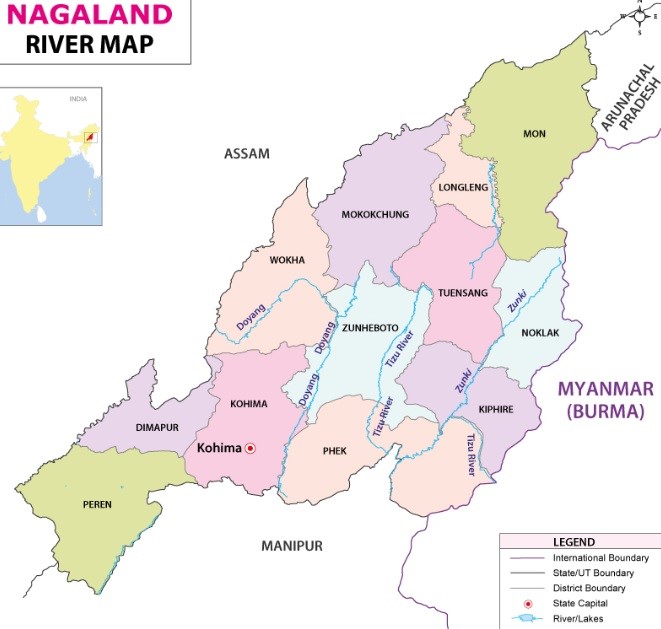
Analysis of the news:
- Union Minister Sarbananda Sonowal and Chief Minister Neiphiu Rio announced initiatives to enhance Nagaland’s waterways at a Stakeholder’s Conference in Dimapur.
- Plans include developing the Tizu Zunki River (National Waterway 101) with a feasibility study for navigation by IWAI and Nagaland’s Transport Department.
- The development of Doyang River Lake will feature community jetties and potential Ro Pax ferries to boost tourism.
- IWAI will provide technical assistance for NW 101 development, focusing on navigation aids, fairway development, and minimal infrastructure needs.
- The initiatives aim to improve inter-regional connectivity in Northeast India via waterways, enhancing economic, sustainable, and efficient transportation.
- Youth are encouraged to train in maritime skills at the Maritime Skill Development Centre for employment opportunities in the marine sector.
- The Ministry of Ports, Shipping & Waterways is working on multiple projects, including the Kaladaan Multimodal Transit Transport Project and linking NWs with the Indo-Bangladesh Protocol Route.
7. “India Aims to Become Leading Aviation Hub with $4 Billion MRO Industry by 2030” – Union Minister Shri Rammohan Naidu
(Source – https://pib.gov.in/PressReleseDetail.aspx?PRID=2033474 )
| Topic: GS3 – Indian Economy – Infrastructure |
| Context |
|
Analysis of the news:
- Union Civil Aviation Minister Kinjrapu Rammohan Naidu announced a uniform 5% IGST on all aircraft and aircraft engine parts, effective 15th July 2024.
- The policy aims to boost the domestic Maintenance, Repair, and Overhaul (MRO) industry and establish India as a global aviation hub.
- Previously, varying GST rates on aircraft components led to challenges like an inverted duty structure and GST accumulation in MRO accounts.
- The new uniform rate simplifies the tax structure, eliminates disparities, and fosters growth in the MRO sector.
- The policy change aligns with the government’s Atma Nirbhar Bharat initiative, emphasising self-reliance and domestic industry growth.
- The uniform IGST rate was recommended by the GST Council in its 53rd meeting on 22nd June 2024.
- The policy aims to reduce operational costs, resolve tax credit issues, and attract investment in the MRO industry.
- The Indian MRO industry is projected to become a $4 billion industry by 2030, driving innovation and sustainable growth.
- The Ministry of Civil Aviation is confident this move will enhance the competitiveness of the Indian MRO sector.
| MRO Industry in India: |
|
| Practice Question: Discuss the recent policy measures undertaken by the Indian government to enhance the Maintenance, Repair, and Overhaul (MRO) industry, and evaluate their potential impact on India’s aspiration to become a global aviation hub. (150 Words /10 marks) |
PRELIMS FACTS
1. India Plans to Tackle Non-Tariff Barriers to Boost Exports to Russia, Sets $100 Billion Trade Target by 2030
(Source: Indian Express; Section: Explained; Page: 15)
| Context: |
| India is aiming to address and eliminate non-tariff barriers (NTBs) faced by Indian exporters in Russia to enhance trade between the two nations. |
Analysis of News:
What are Non Tariff Barriers?
Non-tariff barriers are trade barriers which restricts trade in goods and services by using barriers other than tariffs (tax imposed).
Non-tariff barriers include sanctions, quotas, embargoes and licenses.
- Sanctions: such as increased administrative actions or additional customs to limit a country’s trade.
- Quotas: countries agree to specified limits of products or services to be imported.
- Embargoes: banning the trade of specified goods and services.
- Licenses: use of licenses to limit imported goods to specific businesses.
- Increasingly sanitary and phytosanitary measures are also being used as non-tariff barriers
Background and Bilateral Trade Goals
- This initiative follows a recent meeting between Prime Minister Narendra Modi and Russian President Vladimir Putin in Moscow, where they discussed strengthening trade relations.
- The leaders set an ambitious bilateral trade target of $100 billion by 2030 and began talks for a trade deal with the Russia-led Eurasian Economic Union (EEU), which includes Russia, Belarus, Kazakhstan, Kyrgyzstan, and Armenia.
- The EEU represents a $5 trillion economy.
Nature and Impact of Non-Tariff Barriers
- NTBs include quotas, embargoes, technical regulations, standards, and conformity assessment procedures designed to ensure the safety, quality, and performance of goods.
- While these measures serve important functions, they often act as barriers to exports, complicating trade processes and limiting market access.
Current Trade Imbalance
- India-Russia trade is currently skewed in favor of Russia, primarily due to a surge in petroleum imports.
- Russia has become India’s top oil supplier following the onset of the Ukraine war.
- Despite this, Indian exports to Russia have lagged, leading to a significant trade deficit of $57 billion within the $66 billion bilateral trade in FY24.
Strategic Approach
- India’s strategic approach involves comprehensive discussions and negotiations to mitigate the impact of NTBs on its exports.
- By identifying specific sectors where trade can be bolstered, India aims to balance the trade relationship and achieve the ambitious targets set by its leadership.
2. Imports continue to outpace growing exports; trade deficit widens by 9.4%
(Source – The Hindu, International Edition – Page No. – 1)
| Context |
|
Analysis of the news:
- India’s merchandise exports in June rose by 2.55% to $35.2 billion, marking a third consecutive monthly increase.
- Imports also grew, up 5% to $56.2 billion, widening the trade deficit by 9.4% from the previous year.
- Total merchandise and services exports in Q1 of 2024-25 reached a record high of $200.3 billion, surpassing the previous high of $197.1 billion.
- Services exports for the same period are estimated at $30.3 billion, an 8.9% increase from last year.
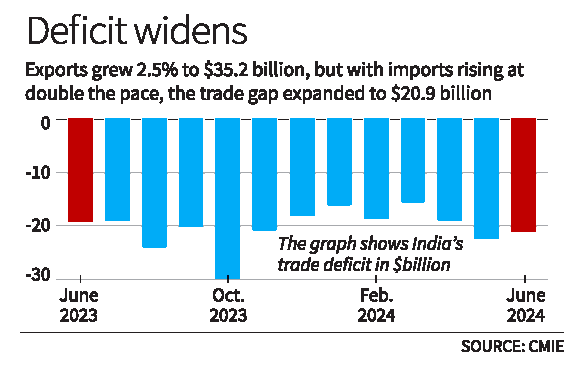
- The government aims to boost exports focusing on six key sectors and 20 countries.
- Despite challenges like geopolitical risks, if growth trends continue, India could exceed $800 billion in total exports this year.
- Major export growth drivers include engineering goods (up 10.3%), electronics (up 16.9%), pharmaceuticals (up 9.9%), chemicals (up 3.3%), and coffee (up 70%).
- Petroleum exports declined by 18.3% in June, while imports rose by 19.6%.
2. Two stealth frigates being built in Russia set to be delivered soon
(Source – The Hindu, International Edition – Page No. – 4)
| Context |
|
Analysis of the news:
- Two stealth frigates being constructed in Russia for the Indian Navy are delayed due to COVID-19, the war in Ukraine, and Western sanctions.
| What is a stealth Frigate? |
|
A guided missile frigate is a warship designed to counter surface ships, submarines and airborne threats.
|
- The first frigate, Tushil, is set for delivery by September, with its commissioning crew already in Russia. The second, Tamal, is expected by February 2025.
- India and Russia signed an agreement in October 2016 for four stealth frigates, with two to be directly imported and two built by Goa Shipyard Ltd. (GSL).
- A $1-billion deal covered the direct purchase of two frigates, while GSL signed a $500-million deal with Rosoboronexport for local manufacture support.
- The frigates are powered by Zorya-Mashproekt engines from Ukraine.
- GSL plans to deliver the first locally manufactured frigate in 2026, followed by the second six months later.
- The construction of the first ship at GSL is progressing, with launch expected soon.
- The Indian Navy currently operates six similar frigates weighing approximately 4,000 tonnes each.
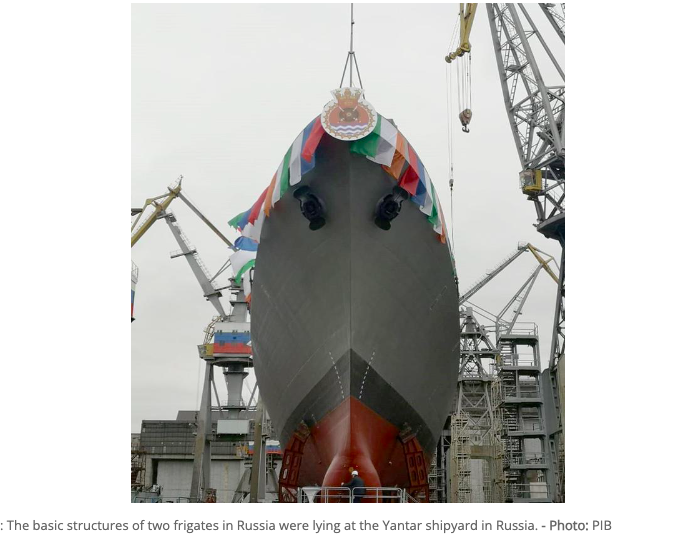
3. World’s rarest whale may have washed up on beach in New Zealand
(Source – The Hindu, International Edition – Page No. – 4)
| Context |
|
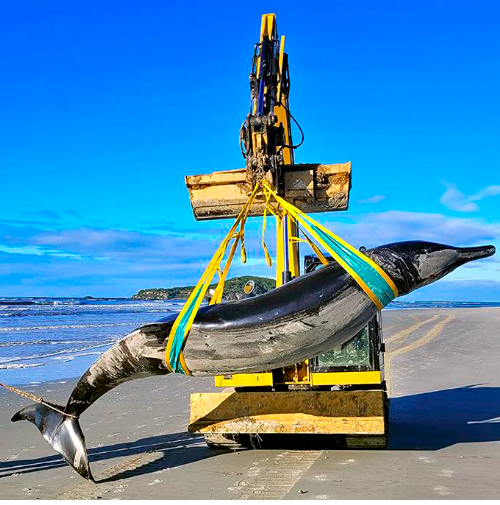
Analysis of the news:
- A Spade-toothed whales, the world’s rarest, have never been sighted alive. Their existence and habits in the southern Pacific Ocean remain largely unknown.
- A five-meter-long beaked whale washed up on a South Island beach in New Zealand is believed to be a spade-toothed whale, identified by its physical characteristics.
- This discovery could provide crucial scientific insights as it might be the first specimen suitable for dissection and study.
- Previous sightings of spade-toothed whales were limited to six specimens, with those found in New Zealand already buried before DNA testing.
- The whale has been preserved for genetic testing, which could take months to confirm its identity.
- New Zealand’s Indigenous Maori tribes will be involved in the examination, considering whales as culturally significant treasures.
- The whales’ deep-sea habits make research challenging, and their precise habitat in the vast ocean remains elusive.


